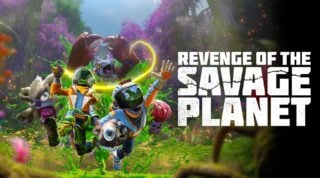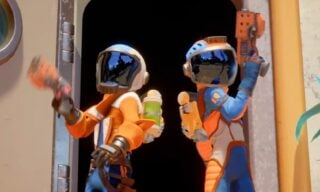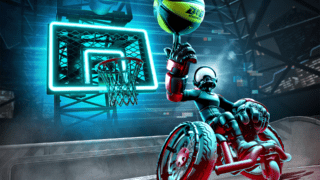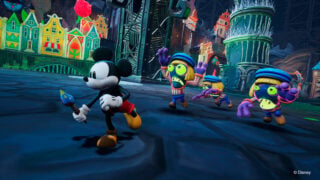‘Google wanted the impossible’ – How Revenge of the Savage Planet is giving the AAA industry the finger
The sequel to 2020’s Journey sees players returning to a colourful, alien-ridden metroidvania

Raccoon Logic’s debut is a game built on Revenge. Revealed at Gamescom’s Opening Night Live, the surprise sequel to 2020’s Journey to the Savage Planet sees players returning to a colourful, alien-ridden metroidvania. Yet make no mistakes – Revenge of the Savage Planet isn’t just a careless moniker, it’s a statement of intent.
Sitting in a downtown Montreal boardroom, the team proudly shows me a hands-off demo of their shiny new sequel. Yet, in a wonderful piece of environmental storytelling, old post-it notes stuck to a side wall and half-erased whiteboards hint at the events that led them here. Originally named Typhoon Studios, their pandemic release was a hit, amassing millions of players.
Sensing the pre-release buzz around the studio, the Savage Planet creators were swiftly bought by Google in 2019. Ready to reap the rewards of corporate ownership, the team found themselves excited to be a first-party studio working on Google’s ambitious Stadia project. Yet the day Journey to the Savage Planet eventally hit Stadia, Typhoon Studios was unceremoniously shuttered.
“Google wanted games that only worked in the cloud – which don’t exist”, Alex Hutchinson, co-founder & creative director, explains. “They were asking us to deliver the kind of games built by 400 to 600 people, huge Marvel license games and Star Wars tie-ins. They said if you make the game and it’s great with 25 people, then we’ll let you hire 500 artists, which is not how it works. No one was talking the same language.”
Thanks to the Covid 19 pandemic, Typhoon didn’t even get to step foot inside a Google office before the corporation decided it was done making video games.
“It’s telling that Google has booths that you book purely to scream in,” adds Hutchinson. “We didn’t get to go into the scream rooms – we didn’t even get to experience the onsite barista!”
Now, these spurned Canadian creators want revenge. Keeping ownership of the Savage Planet IP, once Typhoon studios were dissolved, Racoon Logic was swiftly formed from its smouldering ashes. Retaining most of the core team, these Montreal Misfits returned to their comedy-infused metroidvania to show the world who’s boss. Enter Revenge of the Savage Planet.
Put in a shiny new space suit, the sequel begins with an upbeat corporate message informing you that you’re embarking on a mission to help humanity find a new home, funded by your wealthy new employer, Alta Interglobal. Yet upon arriving at your deadly destination, you discover you’ve been made redundant, abandoned in the far reaches of space with little equipment. Stop me if this sounds familiar.
As you may have noticed during Opening Night Live, Racoon Logic’s corporate experience seems to have given them a new perspective. Dropping its predecessor’s first person view, this sequel shifts the camera behind the players, letting players’ witness their weird little sci-fi colonise in all their goofy glory.
“Upon arriving at your deadly destination, you discover you’ve been made redundant, abandoned in the far reaches of space with little equipment. Stop me if this sounds familiar.”
As our newly-animated protagonist leaps, clambers and shoots his way across a luscious, lethal green world, curious creatures wander over with wide-eyed enthusiasm. They are, of course, swiftly murdered, rewarding the player with some precious, precious goo. If you’re feeling a tiny bit more merciful, players can opt to imprison the indigenous animal populace instead, sending their captured critters soaring into a portal, like a sci-fi twist on MGS 5’s fulcrum system.
Continuing its predecessor’s focus on exploration, this is a game about discovering resources, mapping out vibrant planets and crafting enough gear to make the journey home – except this time, you can bring a mate along for the ride.
As you attempt to build your new homestead, craft weapons, and map out the weird and wonderful biomes contained within each floating rock, you can do so with either an online mate or one blasting alongside you in the same room. Vowing not to have any in-game purchases, “the world needs less games as a service”, the team says– what I’m shown feels like a throwback to a simpler era of gaming.

There’s also a pleasingly systems-based approach to each biome. As grass catches fire and well-aimed shots of goo create new pathways, its disparate game systems collide in satisfyingly immersive sim fashion, allowing players to experiment with their approaches to interstellar exploration.
Whether it’s the litany of corporate satire told via video calls on your crashed ship, weird parodies of forgotten memes, or hilarious email threads buried on your portable computer, Revenge is a game that doesn’t take itself too seriously.
It’s a philosophy that applies to this universe’s weird and wonderful inhabitants. From a comically shrunken racoon that wobbles around, pathetically, to a suite of endearingly goofy animations, there’s a refreshing silliness permeating throughout this metroidvania meets survival romp.
“Its disparate game systems collide in satisfyingly immersive sim fashion, allowing players to experiment with their approaches to interstellar exploration.”
I’m also briefly shown a boss battle against a gargantuan cave monster, some suitably whacky upgradeable guns, a prey-esque goo canon and even an Indiana Jones-esque laser grapple.
Aiming to launch before Q2 next year, the team tells me it will take players upwards of thirty hours to see all that the base game has to offer. With four main planets to explore – and a bonus fifth that the studio is tight-lipped about – Racoon Logic says that the goal with ‘Revenge’ is to inject a dose of colour, fun and playfulness back into Western video games.
In an era where story-led co-op games are a rarity, this fun but deep-looking romp has the potential to become a multiplayer mainstay.

While I have yet to actually play Revenge of the Savage Planet, I’m fully onboard with Racoon Logic’s mission statement of a refreshingly old-school co-op caper. Yet, given the rocky ride the studio’s taken to get here, this sequel’s mere existence feels like an act of defiance.
“Google asked us to make a game for everyone, something ‘universally loved’ like Google Maps”, Hutchinson says. “What does that even mean? If you tell me your favourite film, I may hate it! People just use Maps to get home… No one loves Maps!”
While Revenge of the Savage Planet may not be the elusive universally beloved game, with Racoon Logic self-publishing – thanks to an investment from the ever-present Tencent – this is undeniably the game its creators want to make.
As the team laugh throughout our demo, proudly pointing out goofy in-jokes and explaining meta autobiographical nods, it feels like a return to a simpler age of game development. In an era where soaring costs and avoidance of risk threaten to ruin mid-budget games for good, I leave Montreal feeling more hopeful about the state of this increasingly unpredictable industry.









